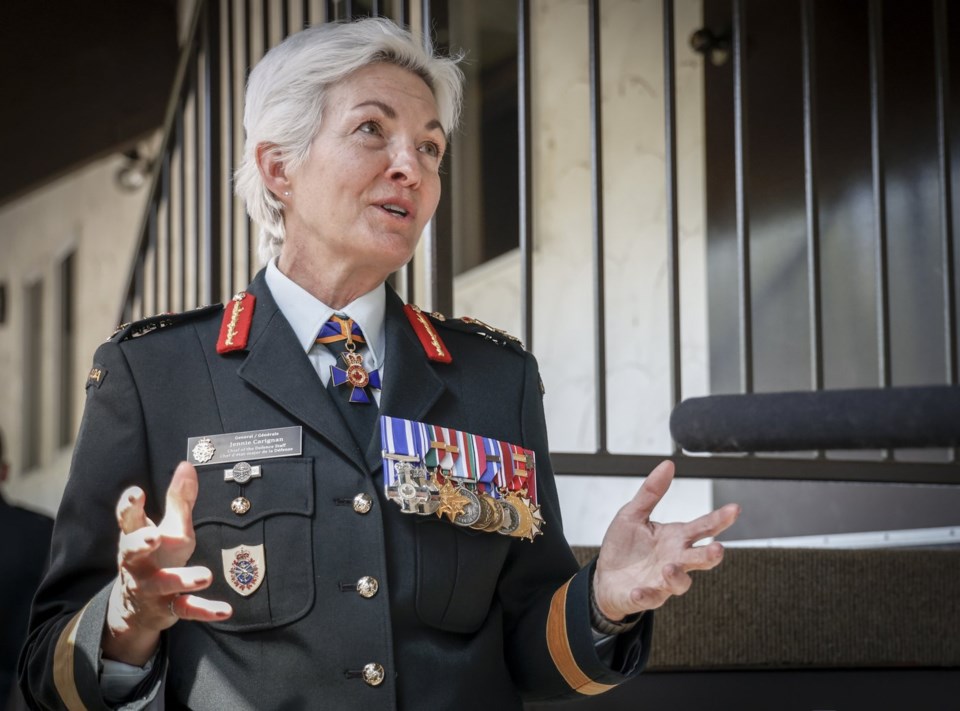CALGARY — Canada’s top soldier is looking forward to a boost in military spending that includes a pay raise for military personnel at a time when uncertainty on the world stage is high.
NATO leaders — including Canada — have approved a plan to dramatically increase defence spending across the Western alliance to five per cent of gross domestic product over the next decade.
Prime Minister Mark Carney said the move to five per cent of GDP — 3.5 per cent for core military spending and 1.5 per cent for defence-related infrastructure — will take place over the next 10 years.
In an interview with The Canadian Press Saturday, Chief of the Defence Staff Gen. Jennie Carignan said work is underway to figure out how to distribute the almost 20 per cent pay hikes promised by Defence Minister David McGuinty.
"It's an envelope that will be adapting to what we need. Some of it will be a pay increase, some of it will be for benefit allowances for specific trades or specific functions," Carignan said.
"Yes there will be a raise this year. Yes that's the aim so we want everything to be ready for the fall and winter time."
Carignan said the amount of the pay hike will depend on a soldier's rank and allowances will be allocated to specific trades where the CAF needs more people.
"For example recruiting and training is a priority. We want to make sure we encourage instructors in our schools so they're going to be additional benefits as an example," she said.
Chief Warrant Officer Bob McCann said the extra pay and benefits will be a morale booster for military personnel.
"We're in a great space right now where there's a lot of attention on defence. For the troops this is outstanding because this is why we joined. We want to serve. We want to be part of Canada's defence," McCann said.
"We want to have equipment to train so everything that's coming is truly positive and we do have 107 trades that are highly competitive with the civilian industry so getting folks in, getting them trained, takes the pressure off the troops that are already there."
Carignan said it's been a good year for recruiting, with the CAF surpassing its objective by 2,000 for the first time in 10 years. She said fewer people are leaving the service as well. About 18 per cent of the new recruits are women.
"A very good retention rate and a lot more people coming in which means we are growing at CAF at the moment and very positive."
Carignan said plans are in place to boost the number of military personnel.
"We are focusing on going back to our full complement of regular Canadian Armed Forces members and reserve force so it's 30,000 reserves we are aiming for and 71,500 regular forces," she said.
"We have additional positions that are also approved and as time goes by and we are close to our ceiling we will add additional forces."
Carignan said the extra funding will help keep Canada safe.
"Our geography does not protect us as well as it used to. We need to have more investment to actually exercise our own sovereignty here in Canada and of course this implies the Arctic," she said.
"It is getting more contested, more traffic, more people interested in this area so of course we have to invest more in the Arctic to make sure our sovereignty is respected."
Carignan wants to see more radar bases be able to scramble jets or ships if required.
"We have to have the sensors in place — once you have seen you have to have the ability to intercept or actually act," she said.
"This is all building blocks that goes to our providing that defensive posture we need to have in the Arctic."
This report by The Canadian Press was first published July 6, 2025.
Bill Graveland, The Canadian Press



